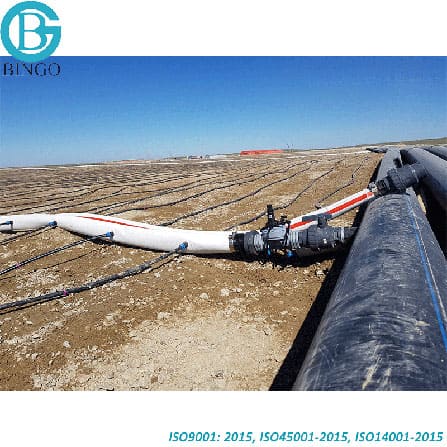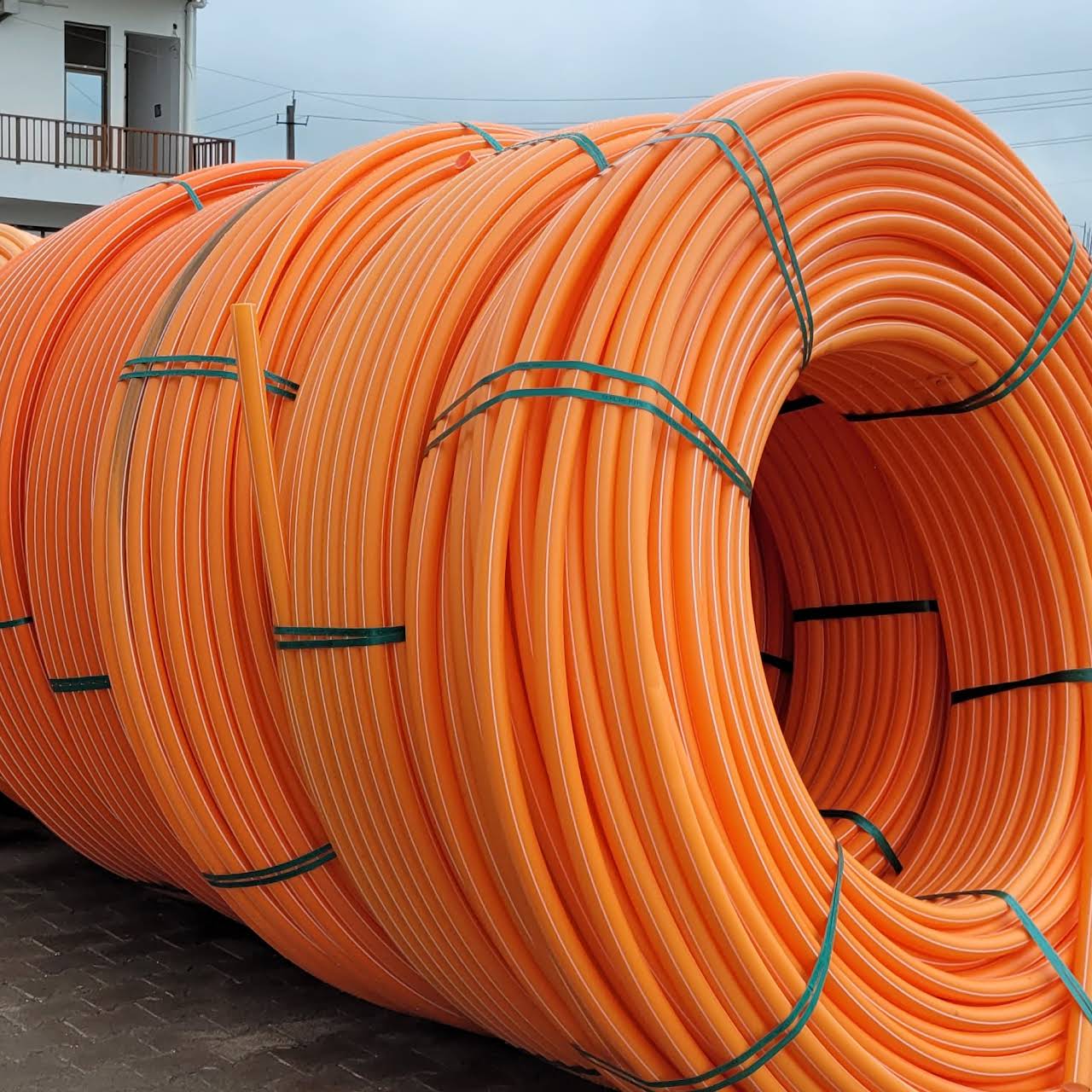Discover the Production Process Behind High-Quality HDPE Pipe and Its Applications
The manufacturing procedure of top quality HDPE pipes is intricate and systematic. It starts with the choice of raw products that boost performance. Following this, ethylene undertakes polymerization to form resin, which is after that shaped through extrusion. Quality control is vital, making certain that the end product meets stringent requirements. Nonetheless, the trip of HDPE pipes doesn't end with manufacturing. Their applications across various markets expose a more comprehensive value worth taking a look at.
Recognizing HDPE: Qualities and Advantages

High-density polyethylene (HDPE) is a functional polycarbonate understood for its durability and resistance to different environmental variables. This material exhibits excellent tensile toughness, making it suitable for demanding applications. Its low-density framework contributes to a light-weight product, facilitating simplicity of managing and installation. HDPE also showcases amazing resistance to chemicals, which reduces degradation when exposed to harsh compounds.
The product's low wetness absorption better boosts its longevity, making it excellent for usage in pipes and tank. Additionally, HDPE is immune to ultraviolet (UV) radiation, making sure that items maintain their integrity also when exposed to sunshine. Its versatility permits for the production of detailed shapes without jeopardizing stamina. The eco-friendly nature of HDPE, often obtained from recycled materials, adds to its appeal, advertising lasting practices in manufacturing. Overall, these residential or commercial properties and advantages make HDPE a favored option for numerous commercial and customer applications.
Basic Material Option for HDPE Manufacturing
The option of basic materials for HDPE production is vital to verify the last item fulfills the wanted specifications and top quality criteria. High-density polyethylene (HDPE) is largely produced from polymerized ethylene, originated from nonrenewable fuel sources such as all-natural gas or petroleum. The top quality of these feedstocks substantially influences the mechanical and thermal homes of the final HDPE.
Additives additionally play a considerable function in improving HDPE's performance, consisting of anti-oxidants, UV stabilizers, and colorants, which boost durability and resistance to environmental variables. The choice process need to think about not just the chemical composition of the raw materials but also their handling characteristics to guarantee effective production.
The sourcing of raw materials need to prioritize sustainability and conformity with environmental policies, as accountable methods are necessary in today's market. Eventually, careful raw product selection lays the structure for producing top quality HDPE pipes appropriate for varied applications.
The Extrusion Refine: Forming HDPE Pipeline
The extrusion process plays a crucial duty fit HDPE pipes, starting with careful material preparation strategies that ensure suitable circulation and uniformity. Just as vital is the design of the die, which straight influences the last dimensions and surface area quality of the pipeline. With each other, these aspects contribute significantly to the efficiency and top quality of HDPE pipe production.
Product Prep Work Methods
Effective production of HDPE pipelines begins with thorough material preparation strategies, particularly the extrusion process. Throughout this phase, high-density polyethylene material is first dried to remove moisture, making certain optimal flow attributes. The resin is then fed into the extruder, where it goes through home heating and melting, changing right into a viscous state. This heating procedure is carefully managed to keep the product's integrity and efficiency. The liquified HDPE is compelled with a die, forming it into a constant pipeline form. Appropriate temperature management throughout extrusion is essential, as it straight impacts the material's properties and the end product quality. When formed, the HDPE pipeline is cooled and reduced to specified lengths, all set for succeeding processing and applications.
Die Design Importance
Precision in die style plays an essential function in the extrusion procedure of HDPE pipelines. The die functions as the last shaping device, directly influencing the pipe's dimensions, wall surface density, and surface area coating. A properly designed die assurances consistent material circulation, lowering defects such as irregularities and weak points. The geometry of the die must be maximized to fit the particular residential properties of HDPE, including its thickness and thermal behavior during extrusion. In addition, the cooling price of the material as it passes with the die can noticeably affect the pipeline's structural stability. Spending in sophisticated die modern technology is important for suppliers aiming to generate top notch HDPE pipelines that meet market requirements and customer expectations.
Quality Assurance Measures in HDPE Production
Although numerous elements influence the high quality of HDPE pipeline production, reliable quality control measures are critical to ensure consistency and dependability in the end product. Secret high quality control techniques include rigorous product examination, validating that the raw polyethylene fulfills well established requirements for purity and thickness. During the extrusion procedure, specifications such as temperature level, stress, and cooling time are very closely kept an eye on to preserve dimensional precision and structural honesty
In enhancement, post-production screening is vital; makers often conduct hydrostatic tests to assess the pipeline's toughness and resistance to stress. Aesthetic examinations for surface area defects further boost quality control. Qualification from pertinent criteria organizations, like ASTM or ISO, provides an extra layer of credibility. By implementing these comprehensive quality control measures, makers can lessen defects, improve performance, and make certain that the HDPE pipelines fulfill the particular demands of various applications, ultimately resulting in client complete satisfaction and depend on in the product.
Applications of HDPE Pipeline Across Industries
HDPE pipelines are utilized throughout different fields because of their longevity and flexibility. In water circulation systems, they assure reliable distribution, while in wastewater management, they give reliable remedies for waste transport. Furthermore, agricultural irrigation networks benefit from HDPE's resistance to corrosion and versatility, making it a perfect option for contemporary farming techniques.

Water Distribution Equipments
A considerable variety of industries depend on high-density polyethylene (HDPE) pipelines for effective water distribution systems. Understood for their resilience and resistance to corrosion, HDPE pipelines are widely utilized in metropolitan water system networks, agricultural irrigation, and commercial applications. Their light-weight nature assists in simple handling and installment, decreasing labor costs and time. Additionally, HDPE pipelines can fit various stress degrees, making them ideal for both low and high-pressure systems. hdpe pipe suppliers Midland TX. The versatility of the product enables smooth combination right into existing framework, reducing the need for comprehensive excavation. In addition, HDPE's resistance to chemical seeping assurances that the water delivered continues to be risk-free and clean, making it a perfect choice for maintaining the quality of safe and clean water throughout numerous industries
Wastewater Management Solutions
Efficient water circulation systems additionally lead the way for cutting-edge wastewater monitoring remedies, where high-density polyethylene (HDPE) pipelines play a significant function. Distinguished for their resilience and resistance to corrosion, HDPE pipelines are optimal for transferring wastewater in different settings. Their adaptability allows for easy installment in complex settings, decreasing the requirement for comprehensive excavation. In addition, HDPE's smooth indoor surface lowers rubbing, enhancing circulation rates and effectiveness. These pipes are likewise immune to chemical leaching, making certain that pollutants do not jeopardize the surrounding setting. Industries, towns, and treatment centers significantly rely upon HDPE pipes for their reliability and longevity, making them a preferred selection for contemporary wastewater monitoring systems. This adaptability underscores the critical significance of HDPE pipelines throughout countless applications.
Agricultural Irrigation Networks
Agricultural watering networks profit greatly from using high-density polyethylene (HDPE) pipelines, which supply reliable and dependable water distribution to crops. HDPE pipelines are light-weight, making them simple to carry and install, while their adaptability enables various setups in varied terrains. These pipelines demonstrate outstanding resistance to deterioration, chemicals, and UV radiation, making sure toughness in severe farming settings. Additionally, their smooth indoor surface decreases friction loss, optimizing water circulation and reducing power costs related to pumping. The durability of HDPE pipelines, typically exceeding 50 years, contributes to lower maintenance and substitute costs. Farmers progressively count on HDPE pipelines to enhance irrigation effectiveness and advertise lasting agricultural techniques, ultimately leading to enhanced crop yields and source preservation.

Future Fads in HDPE Pipe Modern Technology
As the demand for sustainable and efficient framework grows, improvements in HDPE pipeline technology are positioned to transform different industries. Emerging patterns consist of the combination of clever innovations, such as sensing units and IoT capacities, which facilitate real-time monitoring of pipe problems, minimizing maintenance costs and preventing leaks. Additionally, the advancement of innovative manufacturing strategies, such as 3D printing, is allowing the manufacturing of complicated, tailored pipeline styles that deal with specific project requirements.
In addition, the concentrate on recycling and circular economic situation practices is driving the technology of HDPE pipes made from recycled products, enhancing sustainability. Boosted jointing approaches, such as electro-fusion and mechanical fittings, are also enhancing setup effectiveness and reliability. Finally, the expanding focus on ecological policies is pushing producers to embrace greener manufacturing procedures, making sure that HDPE pipes not only meet sector criteria yet additionally promote an even more lasting future for facilities advancement.
Regularly Asked Concerns
How Does HDPE Contrast to Various Other Plastic Products?
HDPE outshines numerous various other plastic materials relating to toughness, here chemical resistance, and flexibility. Its reduced density and high tensile toughness make it optimal for different applications, commonly surpassing options in both performance and durability.
What Are the Environmental Influences of HDPE Production?
The ecological impacts of HDPE production consist of greenhouse gas discharges, energy usage, and possible pollution from producing procedures. In addition, improper disposal can cause soil and water contamination, elevating concerns regarding long-term environmental results.
Can HDPE Pipeline Be Reused?
Yes, HDPE pipelines can be reused. Many facilities accept made use of HDPE for processing, transforming it into brand-new items. This reusing contributes to sustainability efforts, lowering plastic waste while preserving resources and energy in the production cycle.
What Is the Life-span of HDPE Pipes?

How Do Temperature Variants Impact HDPE Pipe Efficiency?
Temperature level variants substantially influence HDPE pipe efficiency, affecting flexibility and strength. Heats can result in softening, while low temperature levels may create brittleness, eventually influencing the pipe's resilience and suitability for various applications in varied atmospheres.